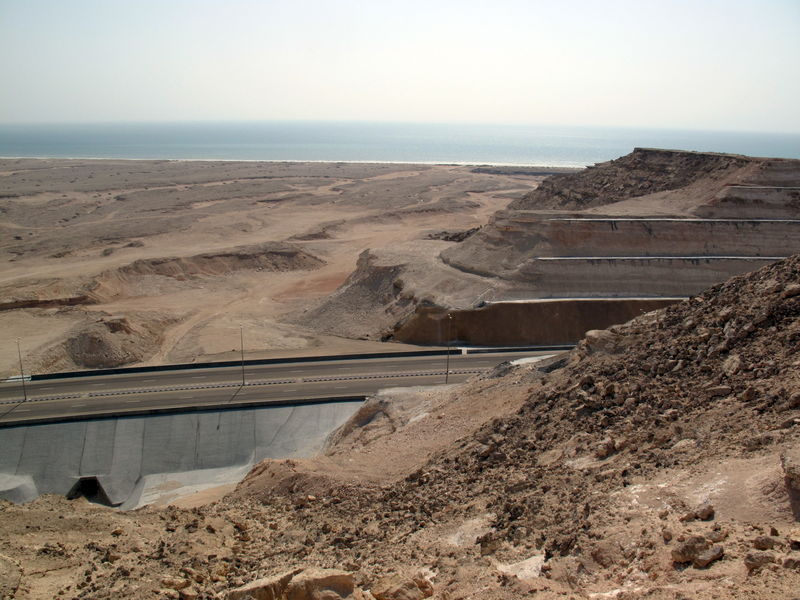By Andrew Torchia and Fatma Alarimi
DUQM, Oman (Reuters) - On a stretch of barren coast 550 km (345 miles) south of the capital Muscat, workers at a ship repair yard swarm over cargo vessels from around the world, labor that will help to determine Oman's fate in an era of cheap oil.
The yard, owned by the government's Oman Drydock Co and operated by South Korea's Daewoo Shipbuilding & Marine Engineering Co (KS:042660), is far from the country's industrial areas in the north.
But it's at the center of the biggest single economic project in the history of Oman, part of efforts to wean the country off exports of crude oil and gas and diversify into downstream industries before the country's limited financial and oil reserves begin to run out.
The government is spending billions of dollars to develop the area around the remote fishing village of Duqm into a sprawling business zone, aiming to attract companies that will create tens of thousands of jobs.
In addition to the ship repair yard and its adjacent port, the Duqm Special Economic Zone will include an oil refinery, a petrochemical complex, manufacturing operations and warehousing and logistics facilities.
A fish processing district will become the focus of Oman's fishing industry. A tourism area aims to bring in hard currency from foreign visitors.
The strategy -- spend lavishly on infrastructure, jump-start key industries with state funds and lobby the private sector to participate -- carries substantial financial risks.
But it is a key plank of economic policy in Oman, a thinly populated country of just 4.4 million people that lacks the deep pockets of neighboring oil exporters such as Saudi Arabia and the United Arab Emirates.
"We are diversifying beyond hydrocarbons," said Saleh Hamood Ali al-Hasni, the executive in charge of handling investment applications at Duqm. "We have to create jobs for the people and attract foreign direct investment."
Other Gulf Arab oil exporting states have cut spending on infrastructure and development projects in the past 18 months as low oil prices have strained their finances.
Oman's finances have also been hit hard, but it does not have as much time as its neighbors. Its financial reserves are estimated in the tens of billions of dollars rather than hundreds, and its proven oil reserves will last only 15 years at the current rate of production, oil company BP (LON:BP) estimates.
So the government is continuing to spend heavily on Duqm and other, smaller projects to move the economy beyond crude oil. Total state investment spending rose 5.5 percent from a year earlier to 2.81 billion rials ($7.3 billion) in the first 11 months of 2015, even as the government ran a budget deficit of 4.07 billion rials, the latest official data shows.
"Oman’s infrastructure and industrial investment drive remain near the top of the government’s agenda and key strategic projects, such as the vast Duqm port and economic zone, will go ahead," analysts at Eurasia Group said in a report.
SPENDING
Five years ago, Duqm had a population of about 3,000 villagers and no commercial air links to the rest of the world; workers coming from outside were housed in tents, portacabins or a retired cruise ship moored at the port.
Now, four-lane highways -- still almost empty of vehicles -- snake across the desert while power and water lines have been laid across scores of square kilometers. Housing complexes and commercial buildings are rising from the sand. An airport opened in 2014, but the passenger terminal is still under construction.
The area's population has risen to about 13,000, including workers, and is set to hit 67,000 in 2020, officials say. In the longer term, authorities talk of a city of 100,000 or more.
Financing all of this building is a challenge. The government has so far spent $1.2 billion and will find it hard to come up with the billions more that will be needed if oil prices stay low.
Hasni said the zone was looking at several options to raise money, including a possible bond issue and a loan from international banks, and had started generating fee income that would help it to finance itself.
A bigger challenge may be attracting enough private investment.
Duqm is marketing its location as an advantage; situated on the Arabian Sea near major shipping routes through the Red Sea to Asia and Africa, it is outside the crowded Strait of Hormuz, which is vulnerable when regional tensions rise.
But an important part of the vision is in doubt. The zone was to have been connected to the other Gulf Arab states by a 2,100 kilometer (1,310-mile) railway due to be built by 2018, allowing the port to receive imports for the entire region and transport them north by rail as far as Kuwait.
Governments' strained budgets have now delayed that project indefinitely, and Omani officials say they may instead focus on building a domestic rail network.
Companies from around the region have expressed their intention to invest $2.15 billion in Duqm, in sectors including housing, tourism, fisheries, commercial services and chemicals, said Hasni, the investment executive.
In a sign of how commercial links may develop in coming years, Iranian companies -- keen to expand after the lifting of economic sanctions on Tehran in January -- are the second biggest source of that investment after Omani firms.
In January, an Omani sovereign wealth fund and Iran's biggest auto maker, Khodro, agreed to study a proposal for a $200 million auto plant in Duqm, for example.

Unlike most other Gulf Arab states, Oman has comfortable diplomatic and economic ties with Iran, and this may help to ensure Duqm's success.